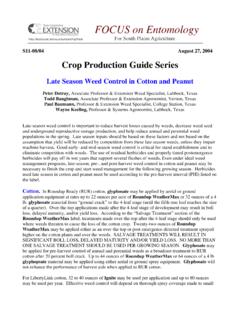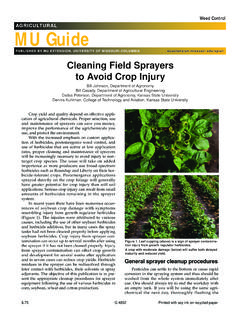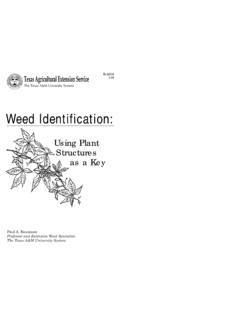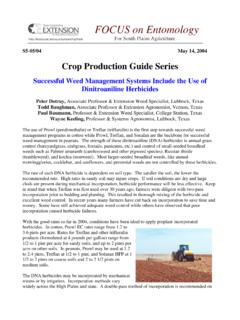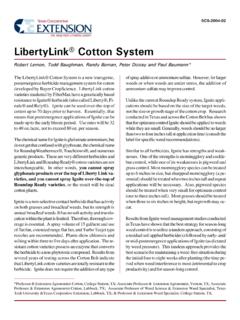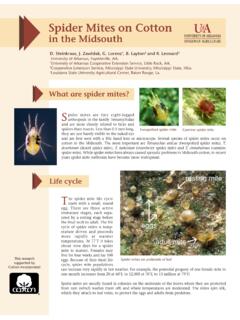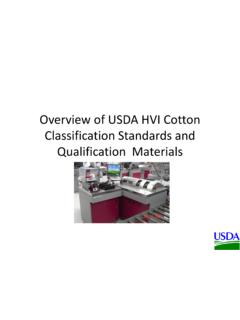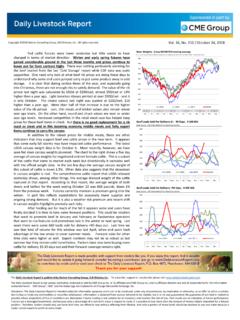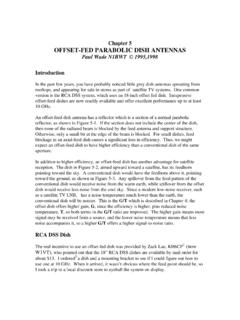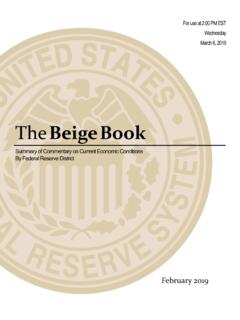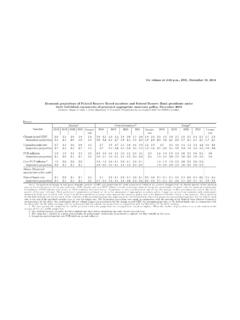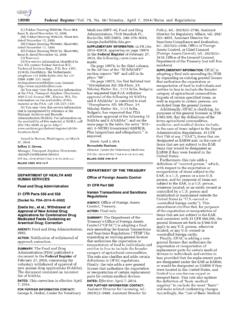Transcription of Using Cotton Byproducts in Beef Cattle Diets
1 Using Cotton Byproducts in beef Cattle Diets Lawton Stewart Extension Animal Scientist beef Cattle Originally Prepared By Johnny Rossi Extension Animal Scientist beef Cattle Introduction Winter feeding accounts for about 40 percent of yearly brood cow maintenance costs. Hay is the primary wintering feed source for beef Cattle , but feeding crop residues has long been a way to reduce these costs. For example, Cattle can eat many Cotton production Byproducts that remain in the field after harvest, including cottonseed, cottonseed meal, cottonseed hulls, gin trash and Cotton stalk residue. Cottonseed, cottonseed meal and cottonseed hulls are widely used as feed ingredients in beef Cattle Diets .
2 Although Cattle producers do not commonly use gin trash or Cotton stalk residue, they also can be fed as the sole feedstuff or with little supple- mentation. Potential as a Feed Source The southeastern states east of the Mississippi River typically produce million acres of Cotton each year, with a yield of bales per acre. One 480-pound bale of Cotton also yields approximately 740 pounds of seed and 150 to 200 pounds of Cotton gin trash, which can be used in beef Cattle Diets . Cattle located near Cotton fields can also graze Cotton stalk residue after the harvest if temporary fencing is constructed. In Cotton -pro- ducing areas, these are excellent alternatives for Cattle producers to lower production costs by feeding Cotton Byproducts .
3 Nutrient Composition The nutrient composition of Cotton Byproducts is listed in Table 1. Table 1. Nutrient composition of Cotton Byproducts (dry matter basis). Whole Cottonseed Cottonseed Gin Nutrient Cottonseed Meal Hulls Trash Dry matter, % Crude protein, % TDN, % NEm (mcal/lb)a NEg (mcal/lb) a Fat, % ---- Ash, % Calcium, % Phosphorus, % Potassium, % Magnesium, % Sulfur, % ---- Copper, ppm Iron, ppm Manganese, ppm Sodium, ppm Zinc, ppm a NEm and NEg = Net Energy for maintenance and Net Energy for gain, respectively. Whole cottonseed is used as a protein and energy Whole Cottonseed source, although its use is limited due to high fat content ( percent) and the potential for gossypol Whole cottonseed is a unique feed because it can toxicity.
4 The energy content of whole cottonseed is supply protein, energy and fiber. Whole cottonseed primarily derived from the oil. is an excellent supplement to poor quality grass hay for dry and lactating cows because it supplies both Cottonseed meal is used as a protein source and does energy and protein in a single feed ingredient. Use not generally make up more than 15 percent of the cottonseed in the Diets of cows and stocker calves, but diet (dry matter). Both whole cottonseed and Cotton - do not feed it to young, pre-ruminant calves. seed meal are good sources of phosphorus and con- tain approximately twice the amount recommended Each pound of cottonseed will provide pounds of for beef Cattle Diets .
5 Crude protein and pounds of TDN on a dry mat- ter basis. Include up to 7 pounds per day in mature Cottonseed hulls are used primarily as a roughage cow Diets to provide pounds of supplemental source in grain-based Diets ; use is limited by low crude protein and pounds of TDN. Whole cot- energy content. tonseed provides sufficient supplements for lactat- ing cows fed a diet containing hay that is at least 9. Gin trash is used as a roughage source in grain-based percent crude protein and 50 percent TDN. If supple- Diets and can supply a portion of the energy needs for mentation is required beyond 7 pounds per day, then Cattle with low nutrient requirements.
6 Other feeds must be blended with the cottonseed. The calcium level of Cotton Byproducts is low and Research in Georgia showed that lactating cows fed should be supplemented in a free choice mineral mix average quality bermudagrass hay had equal rates along with trace mineral salt. of gain when fed either pounds of whole Cotton - seed per day or 4 pounds of corn and pounds of 2 Using Cotton Byproducts in beef Cattle Diets soybean meal per day. With prices of $120 per ton for Poor quality feed may greatly increase intake. One cottonseed, $100 per ton for corn and $300 per ton for study reported an intake of 14 pounds of cottonseed soybean meal, supplemental feed costs were $ per per day when self-feeding first-calf heifers.
7 If intake day for cottonseed supplemented cows and $ per from self-feeders is greater than recommended feed- day for cows supplemented with corn and soybean ing rates, limiting intake to avoid overeating and pro- meal. Conduct a forage analysis to accurately deter- viding another source of feed to reduce risk of poor mine the amount of cottonseed needed to meet the performance and possible reproductive losses would cows' protein and energy requirements. be most economical. Whole cottonseed's high fat content is the primary Do not feed whole cottonseed in self-feeders with a V. limiting factor for inclusion in beef Cattle Diets .
8 Shape because the cottonseed will bridge in the feeder. Supplementing cottonseed at the maximum recom- mended feeding rate (7 pounds per day) will provide Take care when self-feeding bulls because they may pounds of supplemental fat, which is the maxi- eat more than the recommended rates, resulting in mum amount that should be fed to prevent significant possible reduced fertility due to excessive gossypol reduction in fiber digestion. intake. The fat in whole cottonseed has also been shown to Storage and Handling improve reproductive performance. Fat is a precur- There is no advantage to cracking or grinding whole sor to reproductive hormones, and increases these cottonseed, and it should be fed whole.
9 Do not store hormones in the blood. Higher levels of reproductive cottonseed in a grain bin since it is very bulky and hormones may improve pregnancy rates and reduce will not flow through an augur system. Whole Cotton - calving interval. This effect is greatest in cows with a seed is most easily handled with a scoop or front-end body condition score of less than 5. loader. Stocker calves should consume less whole cottonseed Protect whole cottonseed from rain, and store it under than mature cows, since whole cottonseed intake ex- a shelter that provides good ventilation to prevent ceeding 15 percent of diet dry matter decreases stock- moisture accumulation and mold.
10 Do not feed moldy er calf feed intake, daily gains and feed efficiency. A seed; it may contain aflatoxins, which are toxic to research trial in North Carolina showed a reduction in Cattle . daily gains of pounds when steers were fed a corn silage-based diet containing 24 percent cottonseed, Cattle producers with large operations should con- compared with 24 percent of a corn-soybean meal sider building a commodity shed with a concrete floor mix. A feedlot study in Texas also showed a slight to store cottonseed and other Byproducts . Small pro- reduction in daily gain of 4 percent and a 10 percent ducers can pick up cottonseed directly from the gin reduction in feed efficiency when whole cottonseed and store it in a peanut wagon or any type of gravity was fed at 15 percent of diet dry matter in a 90 percent flow wagon.
